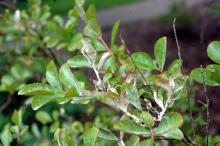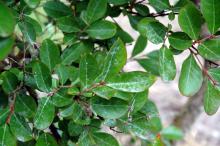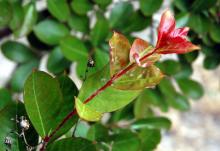Cause Erysiphe australiana (formerly Erysiphe lagerstroemiae) and Phyllactinia guttata, fungi that have not been formally reported from the PNW. Erysiphe overwinters in dormant buds. These buds are covered with conidia in the spring, which start the season's epidemic. Warm days and cool nights along with extended periods of dry weather favor development and spread of the disease. Young and succulent tissues are more susceptible than older hardened tissue.
Symptoms The disease occurs on young shoots in the spring. Small, circular white patches are on young leaves. These leaves may become stunted, attain only a third their normal size, and become abnormally thickened. Affected plant parts become covered with a white, mealy to dusty growth. Internodes are short, flower stems are stunted, and buds often fail to develop flowers. Infected portions often have a reddish discoloration under the white coating. Defoliation may also occur.
Cultural control
- Space plants for good air circulation around the foliage.
- Removal and disposal of fallen leaves may be helpful.
- Grow resistant crape myrtle cultivars including Acoma, Apalachee, Bashams Party Pink, Biloxi, Bourbon Street, Caddo, Catawaba, Centennial Spirit, Cherokee, Choctaw, Commanche, Fantasy, Glendora White, Hope, Hopi, Miami, Muskogee, Natchez, Near East, Osage, Pecos, Sarah's Favorite, Seminole, Sioux, Tonto, Tuskegee, Tuscarora, Wichita, and Yuma. Reactions may vary in the Pacific Northwest, but if markets are in the east and Southeast States these may be helpful. The compact 'Bellini' series of crape myrtles are also resistant.
- Maintain pH range of 5.5 to 6.2 and an EC range of 1.0 to 1.5 for the 'Bellini' series.
Chemical control Fungicides will do best when used before symptoms develop. Few materials have good eradicant activity. Use at 7- to 14-day intervals; using shorter intervals when environmental conditions favor disease development. Alternate or tank-mix products from different groups that have different modes of action.
- Armada 50 WDG at 3 to 9 oz/100 gal water. Do not use a silicone-based surfactant. Not for nursery or greenhouse use. Group 3 + 11 fungicide. 12-hr reentry.
- Avelyo at 3 to 5 fl oz/100 gal water. Group 3 fungicide. 12-hr reentry.
- Bicarbonate-based products. Might be used to supplement a normal program when powdery mildew is first observed. Do not mix with acidifying agents. Thorough coverage is essential. O
- MilStop (85% potassium bicarbonate) at 2.5 to 5 lb/A. Oregon and Washington only. 1-hr reentry.
- Monterey Bi-Carb Old Fashioned Fungicide at 4 teaspoons/2 gal water. H
- Broadform at 2 to 4 fl oz/100 gal water. Group 7 + 11 fungicide. 12-hr reentry.
- Compass 50 WDG at 1 to 2 oz/100 gal water plus an adjuvant. Do not use organosilicate additives. Check for phytotoxicity before using. Group 11 fungicide. 12-hr reentry.
- Concert at 22 to 35 fl oz/100 gal water. May cause injury to buds, blooms or tender new growth. Landscape use only. Group 3 + M5 fungicide. 12-hr reentry.
- Eagle 20 EW at 6 to 12 fl oz/100 gal water. Group 3 fungicide. 24-hr reentry.
- Heritage at 1 to 4 oz/100 gal water plus an adjuvant. Group 11 fungicide. 4-hr reentry.
- Insignia SC at 3 to 6 fl oz/100 gal water plus an adjuvant. Do not use with organosilicate-based adjuvants. Use preventively only. Group 11 fungicide. 12-hr reentry.
- KleenGrow at 25 fl oz/100 gal water for greenhouse use. 48-hr reentry.
- Mural at 4 to 7 oz/100 gal water. Group 7 + 11 fungicide. 12-hr reentry.
- Myclobutanil 20 EW T&O at 6 to 12 fl oz/100 gal water plus spreading agent. May observe a PGR effect. Group 3 fungicide. 24-hr reentry.
- Orkestra at 6 to 8 fl oz/100 gal water. Group 7 + 11 fungicide. 12-hr reentry.
- Pageant at 6 to 12 oz/100 gal water. Do not use with organosilicone-based adjuvants. Group 7 + 11 fungicide. 12-hr reentry.
- Propiconazole-based products. Group 3 fungicides.
- Banner MAXX at 5 to 8 fl oz/100 gal water. 12-hr reentry.
- Infuse Systemic Disease Control at 3 Tbsp/gal water. H
- ProCon-Z at 5 to 8 oz/100 gal water. 24-hr reentry.
- Systemic Fungicide (ferti-lome) at 1.5 fl oz/gal water. H
- Seido at 4 to 5 fl oz/100 gal water plus an adjuvant. Group 50 fungicide. 4-hr reentry.
- Spectracide Immunox Multi-Purpose Fungicide Spray Concentrate for Gardens at 1 fl oz/gal water. Group 3 fungicide. H
- Terraguard SC at 4 to 8 fl oz/100 gal water at 7- to 14-day intervals. Group 3 fungicide. 12-hr reentry.
- Thiolux (80% sulfur) at 3 to 10 lb/A. Group M2 fungicide. 24-hr reentry. O
- Tourney EZ at 1 to 4 oz/100 gal water. Group 3 fungicide. 12-hr reentry.
- Trinity at 4 to 12 fl oz/100 gal water plus a spreader-sticker. Group 3 fungicide. 12-hr reentry.
Note: Lime sulfur and wettable sulfurs have been recommended in the past for use at bud break. O
Biological control
- Cease or Rhapsody (Bacillus subtilis strain QST 713) at 2 to 8 quarts/100 gal water. Active ingredient is a small protein. Efficacy in the Pacific Northwest is unknown. 4-hr reentry. O
Reference Shi, A., and Mmbaga, M.T. 2006. Perpetuation of powdery mildew infection and identification of Erysiphe australiana as the crape myrtle pathogen in mid-Tennessee. Plant Disease 90:1098-1101.




